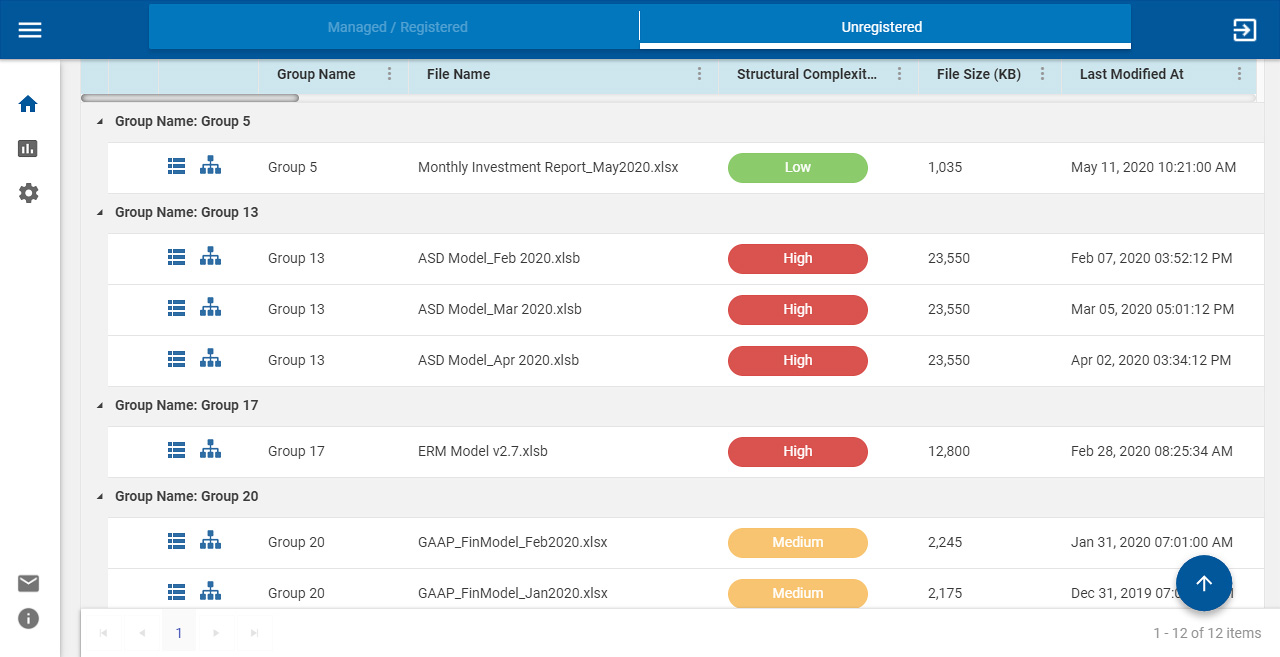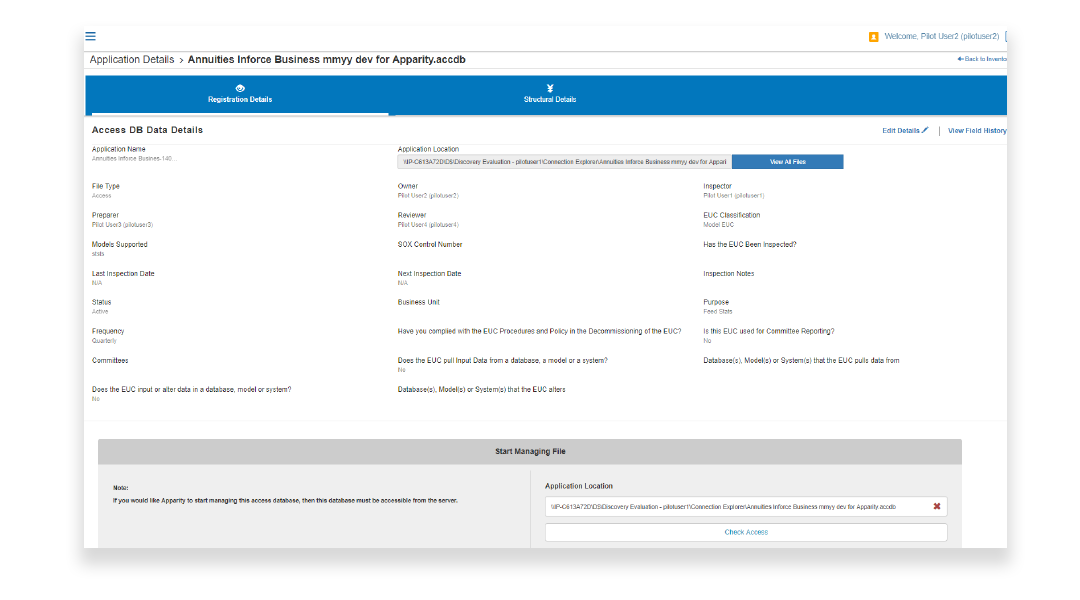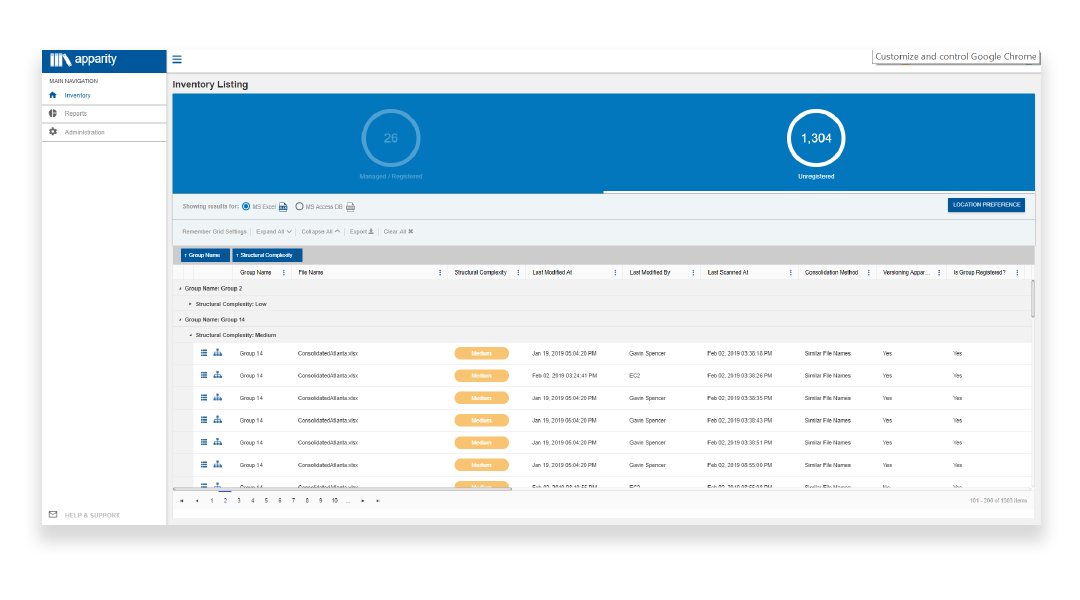Discovery Module
Apparity’s Discovery module gives you a complete view into your End User Computing (EUC) applications. After using Discovery, you’ll be able to answer the crucial question, “What’s out there?”
What’s out there?
Organizations rely heavily on spreadsheets and other EUCs, like Access databases and Python scripts, every day for critical internal processes. However, many are unaware of all these important files that exist in their environment. What’s lurking in the unknown puts your organization at risk for costly mistakes.
Apparity’s Discovery Module solves this problem by scanning an organization’s file storage locations. Then it provides a full list of files with key details captured during the scan. After having a complete understanding of your environment, you can take back control of your files.
Not Just Spreadsheets
Apparity can discover these common EUC file types & more:

Excel Spreadsheets
.XLS, .XLSX, .XLSM, .XLSB, .XLTX

Access Databases
.ACCDB & .MDB

R Scripts
.R

Python Scripts
.PY
Discovery Module Related Features
Scan Setup & Tracking Console
Setting up and tracking scans can seem like a cumbersome and IT heavy task, but Apparity’s web-based Discovery Console is simple and smart. The Discovery Console allows organization scan administrators to schedule scans directly from the web interface without needing to access the Apparity server.
During the setup process, custom scans can be configured so that an organization can focus on files that matter the most. Scan administrators can define exclusion patterns, file “freshness”, and file type.
These settings help eliminate bloated results and save precious time for those responsible for analyzing Discovery results. In addition to one-time scans, scan administrators can set incremental scans on a custom schedule to help find new files (without duplicates).
Most importantly, the Discovery Console provides a central location to view and manage all scan activity, including:
- Summary of all Running, Upcoming and Completed scans
- Detailed insight into parameters, schedules and results
- Troubleshoot a scan
- Abort a scan
- Clone a scan
- Disable/ Enable a scan
Rapid Discovery Assessment
Reviewing the files identified during a Discovery scan can feel like a daunting task. Apparity makes the process more efficient and transparent with its Rapid Discovery Assessment feature. The Assessment form is customized to an organization’s requirements to capture both general information and EUC policy scope information. This information can then be used to determine if files require additional registration and controls.
General information, like department and assessor, can help with assigning assessments to the groups and people most familiar with the file. If a user cannot determine the appropriate assessor from the file name or location, Apparity’s Group Summary provides the last modifiers of each of the file copies. When the assessor has been defined, he or she can use the customized Assessment form to answer questions about the file’s business impact and other factors of policy scope. In addition to determining whether further Registration or Active Management is required, the Assessment form also serves as an auditable file review history.
Connection Explorer
Using data from Discovery, Apparity’s Connection Explorer goes further by visually charting the file connections in a dynamic interface. It’s easy to use and a powerful tool for end users.
As the Discovery module scans an environment, the results are automatically placed into the Apparity Inventory Management System (AIMS). The files are then grouped by an algorithm that can detect when files are copies of a single application. This allows an organization to review an application as a whole, rather than reviewing multiple file versions separately. The Connection Explorer also comes in handy when reviewing thousands, or hundreds of thousands, of files. Additionally, it provides filtering and sorting tools that allow you to find EUCs that require further assessment.
Configurable Spreadsheet Complexity Rating
The Structural Complexity rating is assigned to Discovered files, and it’s completely unique to your organization’s needs. Apparity is able to take any of the file attributes from Discovery and add them to this customized algorithm. Then, the files are separated into high, medium and low structural complexity.
There are many proven benefits to this feature. For example, some organizations use Structural Complexity to determine the level of EUC controls required. While others use it to determine which files should be transferred to IT or specific EUC teams. Some also use Structural Complexity as one component of qualitative risk assessment.
GRC Integration/ API
Today, businesses rely heavily on data analytics and business intelligence to make better sense of raw data in a personalized way. With that in mind, Apparity provides several ways to export or access Discovery data in your central GRC systems, custom applications, business intelligence tools and other enterprise applications.
Central EUC Inventory
With other risk management software, inventory management is a siloed function in which discovery data has to be manually imported into inventory. Unlike competitors, Apparity Inventory Management System (AIMS) is integrated into our entire product suite and provides the ability to manage all your spreadsheet and EUC inventory regardless of stage (discovered, registered, managed).








